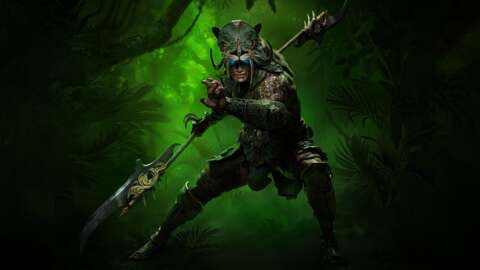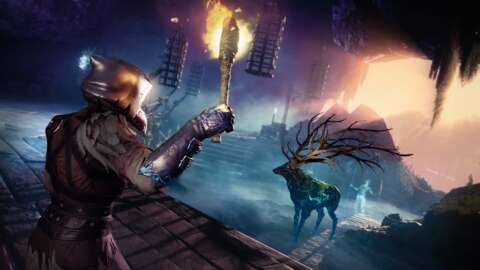Warning! This piece contains spoilers for The Marvels mid-credits scene.
It’s been an uneven year for Marvel movies and shows, with the unimpressive arrival of Ant-Man: Quantumania and the lackluster response to Secret Invasion, but it looks like the studio is ending 2023 on a strong note. Not only have fans been treated to the dynamic and fun-filled multiversal shenanigans of Loki, but director Nia DaCosta’s deep-space adventure The Marvels has arrived, which our review heralded as “a triumph.”
The action-packed film sees Kamala Khan (Iman Vellani), Monica Rambeau (Teyonah Parris), and Captain Marvel (Brie Larson) team up to take down the cosmic threat of Darr-Ben (Zawe Ashton). But we’re here to talk about the new MCU hero introduced in the game-changing mid-credits scene, the variant version of Maria Rambeau (Lashana Lynch) – a.k.a. Binary!
Binary's Origin: Righting a Wrong
This is an interesting thing to explore as when we talk about Binary’s debut in the comics, we're not referring to a new character but rather a new mantle for an already existing one. In this case… Carol Danvers. Yes, the Binary of the comics was Carol, not Maria.
Although Carol debuted years before in 1968's Marvel Super-Heroes #13 (created by Roy Thomas and artist Gene Colan), the Binary mantle didn't appear until 1982's Uncanny X-Men #164. That's notable as in the mid-credits scene that introduces the Maria Rambeau version of the character, we see her alongside Beast (Kelsey Grammer) in what looks like the underground medical bay of the X-Mansion, immediately evoking the comic book connection between the character and the team. Carol's relationship with the X-Men is key to the creation of her Binary alter ego as, in that issue from X-Men super team Chris Claremont and Dave Cockrum, Carol is on a mission with the mutant team and their Shi'ar allies battling the Brood when her new powers manifest.
How did she get her Binary abilities? Well, that's a long story that begins with her origin as Ms. Marvel. In the words of Chris Claremont, she saw a "freak accident combine the best genetic elements of a human and the ancient star-faring race of the Kree." But that alone didn't make Binary. For that to happen, Carol had to lose her Ms. Marvel powers to Rogue (more about that later) and become powerless. That is until the Brood kidnapped the X-Men, including Carol, and experimented on her. Her modified genes reacted to the Brood's meddling and in the depths of space created the hero known as Binary.
That's how the on-page evolution of Carol came to be, though there was a reasoning outside of the comic narrative that played a large part too.
Up until that point in her Marvel Comics run, Danvers' Ms. Marvel had had a rough time of it. Her representation on the page often leaned into misogyny and objectification, which all came to a head during an extremely strange storyline in the pages of Avengers. It was there that Carol discovers that she's pregnant with a baby which is growing exponentially faster than your average child. Soon after — in fact, just three issues later — Carol gives birth. But this is far from a beautiful experience. Instead, she loses all agency and control over her body. Despite her trauma and the fact that she has no idea how she got pregnant, the Avengers celebrate the birth and act as if she's lucky to have had a random super-gestating baby that quickly grows into a man. And if that wasn't all dodgy enough, it's eventually revealed that her son Marcus was actually also the man who raped her, got her pregnant, and forced her to give birth so he could be reborn.
That led to Claremont inducting Carol into the X-Men and crafting some of her most interesting stories, including her connection with Rogue and later the Binary personality. During a Reddit Q&A, Claremont shared some thoughts on Binary and how much he loved developing the new mantle for Carol Danvers, but also how he felt about the mantle quickly being dropped. "Ms. Marvel was brilliant,” he said. “Binary was totally kickass. And I suppose that is partly my frustration, because... Binary was Carol Danvers getting everything she wanted in life, plus an identity that was unique to her, not derived from a pre-existing character."
Despite that fact, the Binary personality made a huge impact, and was recently resurrected by Kelly Thompson and Russell Dauterman during Captain Marvel's "Last of the Marvels" arc. Interestingly, this version of Binary essentially exists as a separate entity from Carol, allowing the pair to fight alongside each other – which feels very relevant to the hero's arrival in the MCU.
Binary's Powers and Abilities
When she was first introduced, the core concept of Binary was that she could wield and embody the immense power of a star. Able to access near-infinite cosmic energy, Binary quickly became one of the most powerful characters in the Marvel canon. This gave her almost unstoppable physical strength as well as expanding her abilities of flight. Basically, imagine Captain Marvel's powers as you've already seen them but turned up to a thousand. She can absorb cosmic energy and wield it in photonic blasts and energy beams. Carol could also change into Binary at will – and it seems that Maria will likely have the same ability in the MCU.
Binary and the X-Men
We've already touched on her connection to Marvel's most beloved team, but seeing as she arrived in an X-Men-centric mid-credits sequence, this topic is worth digging into a little more. Before Carol became Binary, she had an unusual and career-defining entanglement in Avengers Annual #10 with Rogue, who accidentally drained Carol of her powers, resulting in a strange connection between the two. Later, Claremont would actually play with the notion that Rogue’s absorption of Carol's memories and powers meant that the pair were living within the same body and mind, occasionally battling for control.
Despite losing her powers after that run-in with Rogue, Carol's subsequent time with the X-Men was one of empowerment and eventually led to the creation of the Binary persona. It's an interesting choice to make Maria the MCU’s Binary, as there could be a parallel there with some fans feeling the potential of the character had been nerfed after the first Captain Marvel movie. Here we could get a chance to see Maria become the hero she always should have been.
The arrival of Binary potentially changes the hierarchy of power in the MCU (lol) as she's immensely dominant and massively overpowers most of the heroes who currently exist within the world (based on the comics version of the character of course). She's also a great introduction to the more cosmic elements of the X-Men like the Shi'ar and the Starjammers, who have never truly been explored in live action, giving the MCU a way to do something different with their X-Men. And yet, seeing as she's currently part of the Fox X-Men universe, she could have a rather short lifespan as it's possible Deadpool will be following his comic book tradition and killing off the Fox universe when Deadpool 3 hits as the MCU's first R-rated movie in 2024.
The Marvels: The MCU Connection Between Maria Rambeau and Binary
While Maria Rambeau has been around in Marvel Comics since she debuted in 1982's Avengers #246, her characterization there is entirely different. Originally she was a seamstress and supportive mother to her daughter Monica, who became the first female Captain Marvel. Eventually, the comics added a military background for both Maria and her husband Frank in order to align the character a little closer to her movie version. All of which is to say there's no comic book precedent for Maria having powers. But the MCU has set up a smart standard of having Maria essentially act as an alt-universe Carol, starting with Doctor Strange in the Multiverse of Madness where we met the Earth-838 version of the Marvel Comics team known as the Illuminati. Before getting decimated by Scarlet Witch (Elizabeth Olsen), it's revealed that in that universe Maria became Captain Marvel rather than Carol Danvers. Not only is it a fun twist on what we already know of the characters, but it also pays homage to the fact that in the comics it was Maria’s daughter Monica rather than Carol who was the first woman to take the mantle.
Whether intentional or not, the Maria-as-Captain-Marvel cameo in Multiverse of Madness was a great way of establishing the connection between the two characters. That means Maria being Binary makes a lot more sense as in at least one universe she was Captain Marvel, and perhaps even in the universe of The Marvels’ mid-credits scene as well. Perhaps this Maria's Captain Marvel has already lost her powers to Rogue and gained her Binary powers from the Brood! It'll be very interesting to find out where this goes next and whether it's truly the introduction to the X-Men that MCU fans have been waiting for.
Binary in TV and Games
While some of the other characters we cover in our explainers have featured in a ton of games and TV shows, Binary only has two extremely obscure but fun appearances. The first one is for the RPG lovers out there as Carol Danvers' Binary was a character that fans could play as in the Marvel Heroes Classic Roleplaying Game. She was an immensely powered force to be reckoned with there, with Class 1000 Endurance, Incredible Agility, and Unearthly Strength.
It would be decades later that Binary would debut on the small screen in the YouTube series Marvel Mech Strike. This version of Binary appeared as a "Mechasaur," a robot dinosaur built by Tony Stark and Shuri to battle Ultron after he sent New York into the Prehistoric Age!
What do you think of Binary joining the MCU? Let’s discuss in the comments!







